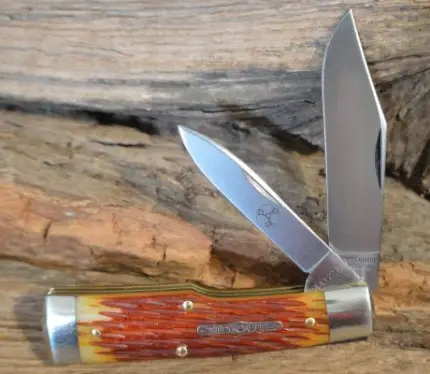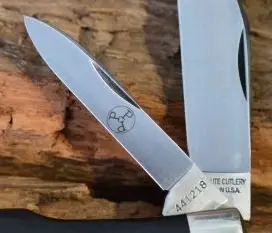|
Great Eastern Cutlery Tidioute #44 Buffalo Jack Gunstock Knife By Gary Zinn  Illustration courtesy of TSA Knives. The hits just keep coming from Great Eastern Cutlery. By hits, I mean their release of irresistible knife patterns. The #44 Buffalo Jack Gunstock run that GEC made in the summer of 2018 is an example, and I got sucked in by one particular item from the run. The production run of the Buffalo Jack pattern included five handle treatments, two on knives bearing the Tidioute tang stamp and three on Northfield branded knives. The Tidioute knife with jigged Goldenrod Bone handle scales was the one that grabbed me. I ordered mine from TSA Knives. Specifications
The key thing that attracted me to this knife was that it is especially robust, with brass liners and pins and blades that are larger than are normally mounted on a medium length jack knife frame. This can be illustrated by comparing the Buffalo Jack with a Case Mini Trapper, a jack knife that has the same closed length. The main blade on the Buffalo Jack is 2-7/8" long and 16mm wide at its widest point, while the Mini Trapper main blade is 2-11/16" long by a maximum of 11mm wide. In addition, the Buffalo Jack main blade is thicker at the spine than the Mini Trapper. Further, a pen pattern secondary blade on a jack knife is usually considerably smaller than the primary blade, but the Buffalo Jack pen blade, at 2-7/16" long by 9mm wide, is larger than the typical jack knife pen blade. The point of all this is the Buffalo Jack Gunstock is an unusually hefty 3-1/2" slip joint knife. The design is strong enough to do some serious cutting. Fit and finish Frankly, writing about the fit and finish of GEC knives is getting to be a bore. Now into their second decade of operation, the GEC production team has making knives down pat, to the point that I could not find anything to criticize about the knife I got. For the record, all parts on the knife matched perfectly, with no gaps or misalignments anywhere, which is saying something given the multiple opportunities for at least minor fitting glitches in a knife with this many parts. The finish work was also flawless. The blades and bolsters are evenly polished to a high satin luster and the work on the handle scales--dyeing, jigging, fitting and polishing--is right on. The Goldenrod Bone handle scales are gorgeous. Function I got a mild surprise when I began to check the function of this knife. I quickly realized that the pull of the primary blade was firmer than I had experienced with previous GEC knives. Further, I discovered that the main blade pull was noticeably firmer than that of the secondary blade, which pulled more like other GEC knives I have. This difference is unusual. I have handled roughly a barrel full of slip joint knives over the years and I cannot recall ever noticing so much difference in the pull of blades working against side-by-side back springs. This is not my imagination at work. Collector Knives, an internet marketer of several knife brands, provides evaluative information, including a judgment call of pull firmness, on many of the slip joint knives they carry. The pull of the Buffalo Jack is rated 7 on a scale of 1-10, while the pull on other knife models (GEC and other brands), is typically rated 5, with a few 4s and 6s. (I presume that the rating of 7 was based on the pull of the primary blade. Collector Knives did not mention the lighter pull of the secondary blade, which I would call a 5; I consider a blade pull of 4 to 6 to be normal.) Closer inspection revealed that the difference in pull is no accident. The spring for the pen blade is thinner than the clip blade spring, so that a stronger spring is matched with the hefty primary blade and a lighter spring with the smaller secondary blade. This is a nuance seldom seen in jack knife designs. Whether the unusually firm pull of the primary blade on this knife is an issue depends on the tastes of the user. It does not trouble me, but as a reviewer I need to share this information with readers. The blades cycle smoothly with a firm half stop, which is top dead center on both blades. A folding knife that half stops is desirable, because the half stop adds a measure of control, especially when closing the blades. Half stops are a feature of well designed, high quality slip joint knives. The half stop is especially appreciated on this model, due to the extra firm pull of the primary blade. The knife frame is 1/4" thick and the handle scales add enough bulk to bring the overall handle thickness up to 9/16". The 3-1/2" long handle is not long enough to fill my medium-large hand, but the overall girth and increasing width of the handle (9/16" at the front, 3/4" at the butt) results in it fitting my palm nicely. For a working knife, the handle of this knife is as comfortable and secure as one is likely to find in a pocket knife with a 3-1/2" frame. The edges on the flat ground blades are excellent. I have a qualitative ranking system for describing the sharpness of knives. My grades are NS (not sharp), SE (sharp enough), VS (very sharp) and ES (extremely sharp). Out of the box, I expect the factory edges of most knives from reputable makers to be at least SE, with an edge keen enough to do routine cutting tasks. The factory edges on my knife (formed by a very narrow micro bevel) were Extremely Sharp (ES). This bodes well for the cutting performance of the knife. I have other GEC knives with 1095 steel blades that hold their edges well and are a snap to sharpen, as needed. I do not anticipate any edge retention deficiencies, or sharpening problems, with this knife. GEC brands in brief Some readers may not be familiar with the Great Eastern Cutlery product lines. The company uses four tang stamps, Tidioute, Northfield UN-X-LD, GEC and Farm & Field Tool, to distinguish among their products. The majority of GEC pocket knife production runs are Tidioute brand, featuring 1095 carbon steel blades, various handle materials and a level of fit and finish exemplified by the knife reviewed here. Northfield UN-X-LD is a premium line of knives, with sometimes exotic handle materials and the highest attention to design details, blade and handle finish. Knives with the "GEC" tang stamp are generally made with 440C stainless steel blades and a limited number of handle materials. Occasional runs of fixed blade knives are released with the GEC brand designation. Farm and Field Tool knives are no-nonsense, sturdy, utility knives with steel frames, heavy duty synthetic handle scales and reinforced pins. More detailed information on the tang stamps and product lines is available on the www.greateasterncutlery.com website. The GEC website contains a list of the distributors and dealers who market GEC knives. Conclusion The Tidioute #44 Buffalo Jack Gunstock is the fifth GEC knife that I have reviewed. It is the best one yet, in terms of workmanship and I really like the design. Taken together, the materials, workmanship and function of the knives I have reviewed lead me to the opinion that Great Eastern Cutlery is making the best production slip joint folder knives currently available. Anyone who appreciates traditional style pocket knives, but does not have one or more made by GEC, is missing out on a good thing. Postscript I usually do not pay much attention to script or symbols that are sometimes etched on the sides of knife blades. If such text or hieroglyphics provide key information about the knife (model designation, blade steel, etc.), fine. Otherwise, I tend to shrug off words, numbers, or symbols as garnish, having no bearing on the functionality of the knife. This attitude comes naturally to me, because I have always viewed knives as tools. I noticed, but took little note of, an unusual symbol on the pen blade of the #44 Buffalo Jack knife (see image below). I have learned, though, that this odd symbol conveys highly significant information about the knives on which it appears. The three iterations of the letter P, arranged like wheel spokes within the bordering circle, symbolize that the knives bearing the symbol are part of the "Pattern Production Premier" of the GEC #44 factory pattern. In other words, the #44 pattern is new to the GEC factory pattern library and the run of five knife models, released between July 11 and August 24, 2018, were the first knives built on the pattern.  Illustration courtesy of TSA Knives. The information conveyed by this symbol is highly significant to knife collectors, but it leaves me in a personal quandary. I am not a collector; I buy a knife with the intention of carrying and using it. What am I going to do with my Buffalo Jack? As a part of the pattern production premier of the #44 GEC pattern, it has unique status as a collector item, but I do not have a coherent collection of pocket knifes to which I might add it. I learned the meaning of the triple P symbol on these knives from a YouTube video by TheApostleP. I do not do videos, but I learn things from videos posted by certain knowledgable and thoughtful product reviewers and TheApostleP is one of those. I thank him for teaching me the meaning of the triple P symbol on these GEC knives. |